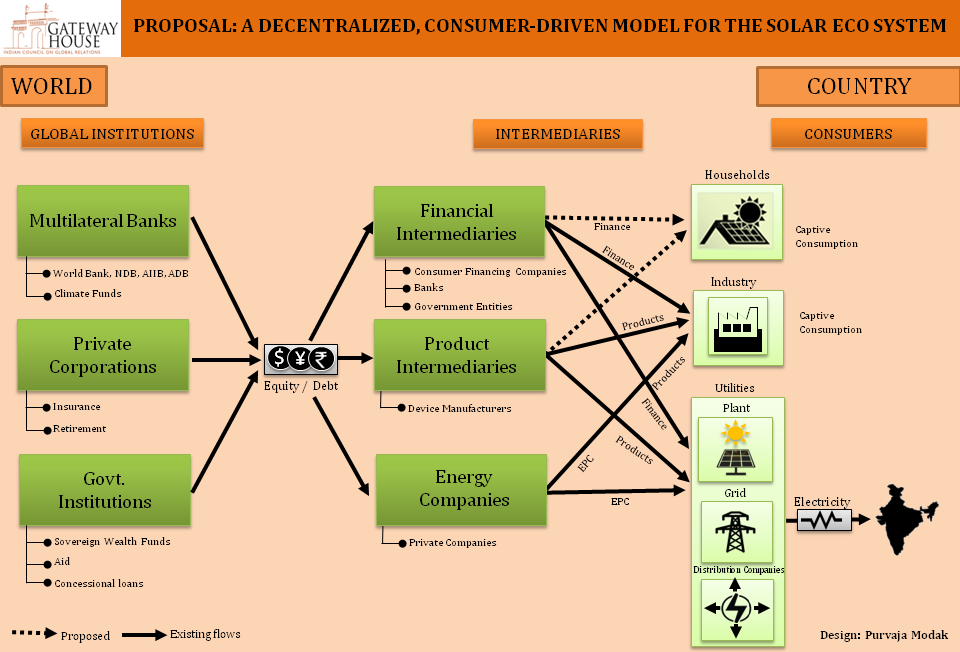The transition from fossil-fuel based energy usage towards renewable energy sources needs to be accelerated. The issue is at the developing country level, where a lack of funds and technology – both promised by international institutions but not delivered – exacerbates the problem. Where financing is available, very few “bankable” projects exist for global investment.
To hasten the transition, a new decentralized, consumer-based renewable energy approach must be adopted. Solar energy technology is particularly suited for this and can see early gains for climate change. The G20 can create policies to help develop products for consumers and facilitate global private capital and multilateral finance towards this goal.
Challenge
- The transition from fossil-fuel based energy usage towards renewable energy sources needs to be accelerated.
Renewable energy comprised 2.8% of global energy consumption in 2015[1]. Despite improvements in technology and natural advantages over conventional energy, the adoption is not growing fast enough to meet the global commitments to climate change[2]. The key challenges are:
• Availability of appropriate products, which can be easily and widely adopted by consumers
• Where products do exist, market distortions make them financially unviable
- Financing deficit for renewable energy infrastructure.
Particulary true for developing economies. The $100 billion per annum Green Climate Fund is grossly insufficient to meet the goals, and under 10% is committed[3].
• Lack of specialized financing for both small and large-scale solar purchases
• Lack of a secondary market – a key enabler for consumer finance for small-scale solar products.
Proposal
Recommendation: Convert solar power into a consumer product and channel global investments towards decentralised, retail solar infrastructure projects.
Part I: Encourage development of solar-based consumer products
- Encourage renewable energy companies to design standardised home products that can easily be purchased and installed by consumers. Solar panels and systems are not designed for small scale installations. For instance, installing a home solar system requires technical expertise for gauging orientation and connecting electrical circuitry – similar to mega-solar installations. Existing models are unwieldy[4]. Required instead are panels that are as easily installed as other consumer appliances such as refrigerators and televisions.
- Encourage global use of electric vehicles. There is a distortion to overcome: in most developing countries, the electric grid carries subsidised, coal-generated power. Consumers therefore don’t pay market rates for a unit of energy, making it difficult to substitute. Petroleum, on the other hand, is up to five times more expensive for consumers, as it is often aligned to global market prices. Therefore, a better policy will incentivise consumers to substitute petroleum with solar, instead of coal for solar. A viable option is a combined Solar-Electric Vehicle model that provides an immediate and greater monetary benefit to consumers. This is not the Tesla, Leaf or Bolt model[5], but more in line with the dominant mode of transport in the emerging world, the two-wheeler which is suited for home-solar recharging[6]. This encourages the use of renewable energy to mitigate the negative effects of carbon emissions from power generation and from transport. Consumer financing companies will find this more attractive because vehicles (as opposed to used home solar systems) have a ready resale market, should there be loan defaults. This solution will require research and investments in higher capacity batteries and public charging points.
Part 2: Direct global long-term savings towards solar consumer finance.
- Create specialised consumer financing for decentralized solar products. Specialized consumer solar finance intermediaries are needed to create markets for solar products in the image of automobile and home finance providers. These companies may require initial equity investment, as well as access to cheap, long-term debt capital to operate effectively. Such retail loans can be bundled and resold to global financial institutions and investors interested in renewable energy.
- Encourage multilateral banks and global private capital to invest in such consumer finance companies. Instead of looking for bankable renewable energy projects around the world to fund, global investors will find it easy to fund specialised consumer financing intermediaries (as described above) with experience with retail banking, which follow global accountability standards, and are monitored by national regulators

Country examples:
- India has taken the lead[7] on renewable energy, particularly solar, to meet its global and national climate change goal. However, despite solar energy being cheaper than nuclear, hydro and natural gas, and nearly on a par with that produced by coal[8], only 2.4% of the country’s total solar energy installation is residential rooftop solar[9]. Getting loans for such small scale systems is difficult, as is installing and implementing net metering. An experiment is already under way: Multilateral support has come from the the World Bank which has initiated a $1 billion distributed solar programme for India called the Grid-connected Rooftop Solar Photovoltaic (GRPV) Program, financed via India’s largest public-sector bank – the State Bank of India[10].
- Bangladesh has the most successful large-scale adoption of small-scale products – 3.7 million solar rooftop systems – through World Bank support[11]. However, these are extremely low capacity, just 10-watt and 20-watt systems[12]. While these help the marginalized get electricty, the overall impact of replacing fossil fuels is negligible.
- Germany has nearly 40 GW megawatts of installed solar capacity, of which 30 GW is in solar rooftops[13]. Nearly 1.5 million small scale solar systems have been installed, with subsidies from Berlin, and created an estimated 38,000 jobs[14]. The European Commission has pushed for a move to market based mechanisms[15].
- The U.S. has an estimated 32 GW of installed solar capacity, of which 13.2 GW (41%) is small scale[16]. In 2014 and 2015, renewable energy (solar and wind) accounted for more than 50% of the new electricity generation in the country[17]. Net metering has been an important enabler for encouraging distributed solar, and the market has been catalysed by permitting leasing[18].
- At 35 GW, Japan has the world’s third largest installed solar generation capacity, post Fukushima. High subsidies have enabled adoption[19], but it is unsustainable and creates market distortions.
References
- BP Global, Energy Economics, “Statistical Review of World Energy”,
https://www.bp.com/en/global/corporate/energy-economics/statistical-review-of-world-energy.html - “Climate Negotiations, International action on climate change, EU Action, European Commission,
https://ec.europa.eu/clima/policies/international/negotiations/paris_en - “Resources Mobilized”, Contributors, Green Climate Fund,
https://www.greenclimate.fund/partners/contributors/resources-mobilized - Solar City, “Solar panel diagram”,
https://www.solarcity.com/residential/solar-energy-faqs/solar-panel-diagram - Edelstein Stephen, “Electric Car Price Guide”, Green Car Reports, 17 January 2017,
https://www.greencarreports.com/news/1080871_electric-car-price-guide-every-2015-2016-plug-in-car-with-specs-updated - Hero Electric,
https://heroelectric.in/e-sprint-2/?view-product=y - Ministry of New and Renewable Energy, Press Information Bureau, Government of India, “A new dawn in Renewable Energy”, 18 December 2016,
https://pib.nic.in/newsite/PrintRelease.aspx?relid=155612 - Bhandari, Amit, “Nuclear energy hurting balance sheets”. Gateway House, 16 March 2017,
https://www.gatewayhouse.in/westing-house/ - “India Solar Rooftop Map 2016“, Bridge to India,
https://www.bridgetoindia.com/reports/india-solar-rooftop-map-2016-edition-2/ - World Bank, “World Bank Approves an Additional $22.93 Million Grant to Support Grid-connected Rooftop Solar Program in India”, Washington, November 15, 2016,
https://www.worldbank.org/en/news/press-release/2016/11/15/world-bank-approves-additional-usd22point93-million-grant-support-grid-connected-rooftop-solar-program-india - World Bank, “Annual Report 2016“, p. 57 and 64,
https://www.worldbank.org/en/about/annual-report - Xiaoyu, Chang, “Lighting rural Bangladesh with rooftop solar & carbon credits”, 24 March 2015,
https://blogs.worldbank.org/climatechange/lighting-rural-bangladesh-rooftop-solar-carbon-credits - International Solar Aliiance and Yes bank Report, “Compendium of Global Success Stories in Solar Energy“, October 2016, p.74,
https://intsolaralliance.org/docs/CompendiumofGlobalSuccessStoriesinSolarEnergy.pdf - Strom Report, “Renewable energy in Germany 2014”,
https://1-stromvergleich.com/medien/renewable-energy-germany.png - European Commission Press Release,“State aid: Commission adopts new rules on public support for environmental protection and energy“, Brussels, 9th April 2014,
https://europa.eu/rapid/press-release_IP-14-400_en.htm - US Energy Information Administration, “Electric Power Monthly, 24 March 2017,
https://www.eia.gov/electricity/monthly/epm_table_grapher.cfm?t=epmt_6_01_a - US Department of Energy, “2015 Renewable Energy Data Book”, p.3,
https://www.nrel.gov/docs/fy17osti/66591.pdf - Simon J, T. Tian, C. Liu, and M. Miller, National Renewable Energy Laboratory, “Case Study Analysis of U.S. Policy Solutions to Enable China New Energy Cities, p 14 and 20,
https://www.nrel.gov/docs/fy15osti/63529.pdf - Ninomiya, Yasushi, “Domestic and Overseas Renewable Energy Markets 2017”, Institute of Energy Economics, Japan, 22 December 2016, p 2,
https://eneken.ieej.or.jp/data/7171.pdf - G20 Australia 2014, “G20 Principles on Energy Collaboration”,16 November 2014,
https://www.g20australia.org/sites/default/files/g20_resources/library/g20_principles_energy_collaboration.pdf - Prime Minister’s Office, Press Information Bureau, Government of India, “Highlights of PM’s Statement on Energy at G20 Summit“, 16 November 2014,
https://pib.nic.in/newsite/PrintRelease.aspx?relid=111449








